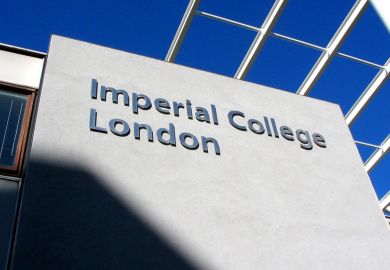Try this quiz: what do fashion designers Vivienne Westwood and Christopher Bailey, broadcaster and writer Charlie Brooker and sculptor Sir Anthony Caro have in common? They’re all graduates of the Westminster School of Media, Arts and Design – or at least one of its previous incarnations.
The school is celebrating a key moment in its history. The department was in effect born 25 years ago when Harrow College of Higher Education, a specialist arts institution, merged with the Polytechnic of Central London, which later became the University of Westminster.
But, as Kerstin Mey, the school’s current dean pointed out, the past quarter century has been notable for more than simply producing famous alumni. In the 2014 research excellence framework, Westminster was third overall in the art and design: history, practice and theory unit of assessment (UoA), and it was joint fifth overall for communication, cultural and media studies, library and information management. In both these UoAs, Westminster also placed strongly in terms of output and impact.
“We have built a very excellent research record in terms of the quality of our output and impact,” she told Times Higher Education. “We occupy a leading position in art and design, and media and communication. That’s really significant because the research quality also underpins the international reputation of our portfolio across the disciplines: fashion, photography and film, journalism and mass communication.
“There was an awareness that we were in very competitive fields and that significant effort was required to maintain a leading position within these fields, and our academics have risen to the challenge and worked particularly well in the area of impact in both areas.”
To evidence the university’s impact, Professor Mey cited the Oscar-nominated The Act of Killing, a film about the 1960s genocide in Indonesia, and The Family Legacy, a film about sickle-cell anaemia, directed by Westminster academics Joshua Oppenheimer and Jane Thorburn, respectively.
“The Act of Killing created a debate in Indonesia and beyond around the genocide but also [sparked discussions about] the aesthetics at work in order to articulate this history and the contemporary situation,” Professor Mey said. “Jane Thorburn’s film was used here by the NHS for the west London communities and awareness-raising.”
Strong links with industry
Besides research accomplishment, Professor Mey continued, the school can take pride in its strong connections with industry – specifically its “practice-focused, research-oriented education”, which has been “very influential” in training and developing the new generation of professionals and also in providing leadership for the creative industries.
“Bringing together practice and research has enabled us to play an innovative role in many of our subject areas and to offer an education that is very relevant for our students – underpinned by placements in industry/businesses in London, and internationally,” she said. “We have to recognise that we have an extremely informed pool of potential applicants who will make a very clear choice [about] why they go to an institution.
“I do think that evidencing how we support the employability of our students will be crucial, but we need to think of employability in a broad context because the labour market in a global world is changing radically.”
On the recent decision to restructure the department and change its name from “faculty” to “school”, Professor Mey suggested that one factor was a desire to encourage more interdisciplinary working.
“The faculty was previously made up of very strong departments with strong identities fostering disciplinary excellence,” she said. “If you look at the cultural situation, as we are in a knowledge and service society, by restructuring our faculty we want to maintain disciplinary excellence but create more opportunities for exchange, sharing and collaboration across our areas of expertise.”
In a climate where change occurs at a furious pace, Professor Mey said that she wanted the school to “maintain the currency of our academic portfolio” in its next 25 years.
“That means that we build and include taking on board the continued changes that occur through digitisation and media and technology convergences,” she said. “That is, in itself, quite demanding because while we’re in the middle of it, it’s not that easy to anticipate where it’s going.”
Developing “international partnerships”, engaging in knowledge exchange and strengthening the postgraduate offer are also on the agenda.
In numbers
Westminster was third overall in the art and design: history, practice and theory unit of assessment in the REF 2014
Campus news
Queen’s University Belfast
Queen’s University Belfast unveiled its electric-powered DeLorean on the exact date that Marty McFly went “back to the future” in the iconic car. In the Back to the Future films, “Doc” Brown modifies the Belfast-built vehicle for use as a time machine. Marty employs it, in the second film, to travel to 21 October 2015 to prevent his future son being sent to prison. Queen’s staff and students have spent 18 months restoring and modifying their DeLorean, which is thought to be the first to be “built” in Northern Ireland since the Belfast factory ceased production in 1983.
Aberystwyth University
A scholarship fund will be set up using a donation of more than £500,000 to Aberystwyth University by two alumni. Peter Hancock and his wife, Patricia Pollard, made the £506,000 gift in recognition of the scholarship that enabled Mr Hancock, a geologist and academic who now lives in New Zealand, to study at the institution 50 years ago. The funding will be used to support second-year undergraduates in financial need.
Newman University
A Birmingham-based Catholic institution will validate degrees at a Chinese partner. Newman University has signed an agreement with Guangdong University of Education (GDUE), in Guangzhou, that begins with Newman validating a one-year professional graduate certificate in management and business for GDUE students. Those who complete the course with distinction and have sufficient English language skills will be eligible to apply for a place on Newman’s own MBA course in Birmingham.
Brunel University London
A new thinktank has been established to explore the UK’s relationship with Europe and its impact on human rights. Funded by Brunel University London, the Britain in Europe Research Network brings together academic scholars, legal practitioners and non-governmental organisations to consider issues around UK and European Union law from an interdisciplinary perspective. The group hopes to “influence public policy on human rights by publishing original research, at a time of growing concern about the relationship of Britain with European institutions”, said the group’s founder, Dimitrios Giannoulopoulos, senior lecturer in the Brunel Law School.
University of Kent
The chemical produced by decaying body tissue triggers a fight or flight response in humans, according to research. Arnaud Wisman, a lecturer in psychology at the University of Kent, was one of the authors of a study that found that exposure to putrescine increases vigilance and a desire to escape or engage in aggression. The researchers believe that the study is one of the first to show that a specific chemical compound can change human behaviour.
University of Hertfordshire
English schoolgirls are less satisfied with their lives than boys and feel more pressure to succeed, a report authored by university researchers has revealed. The study by academics at the University of Hertfordshire in collaboration with the World Health Organisation shows that as girls hit their teenage years, the proportion who rate their happiness as high drops from 81 per cent (aged 11) to 55 per cent (aged 15). In comparison, 74 per cent of 15-year-old boys say they are happy, down from 81 per cent at age 11.
Nottingham Trent University
Researchers have developed a technique to use smartphones to locate veins in people’s arms. Academics at Nottingham Trent University say their design is a low-cost way to help clinicians with difficult injections, such as those on small children or people with a fear of needles. The invention, for which a patent is pending, involves fitting a smartphone camera with a near infrared filter and adjusting the flash to the correct frequency. It is then inserted into a holder that is strapped to the patient’s arm, allowing the clinician to see the veins without having to hold the phone steady.
University of Sheffield
An installation artist and academics have joined forces to create a 30m (90ft) long inflatable sculpture of an E. coli bacterium. The piece, which is about 5 million times bigger than a real bacterium, has been created by the artist Luke Jerram in consultation with academics from the University of Sheffield. It was unveiled as part of the university’s KrebsFest; a seven-week festival celebrating the life and work of the university’s Nobel laureate, Sir Hans Krebs, who was awarded the Nobel Prize in Physiology or Medicine in 1953 for discovering the Krebs cycle – the conversion of food into energy within a cell. The theme of the festival is “hidden worlds”, shedding light on unseen wonders of nature.
后记
Print headline: Impact? The Act of Killing sparked debate worldwide





